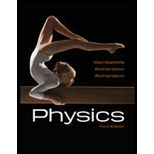
(a)
Draw the equivalent circuit with one resistor and one capacitor.
(a)
Answer to Problem 94P
The equivalent circuit with one resistor and one capacitor is shown below.
Explanation of Solution
The resistor
The capacitors
This capacitor is in series with
Substitute the value of
Conclusion:
Substitute
Substitute
The equivalent resistance and capacitance values are used to draw the equivalent circuit and shown below.

(b)
Find the charge on the capacitor
(b)
Answer to Problem 94P
The charge on the capacitor
Explanation of Solution
The current in the resistor with fully charged capacitor is zero. Since there is no flow of charge from the battery to the capacitor.
Write the equation for charge on equivalent capacitor,
Here,
Conclusion:
Substitute
This charge is same on the charge of capacitor
Substitute
Then the voltage drop across the capacitors
Then the charge on the capacitor
Substitute
Therefore, charge on the capacitor
(c)
Find the time constant of the circuit.
(c)
Answer to Problem 94P
The time constant of the circuit is
Explanation of Solution
Write the equation for time constant,
Here,
Conclusion:
Substitute
Therefore, the time constant of the circuit is
(d)
Find the time at which the voltage across the three capacitors
(d)
Answer to Problem 94P
The time at which the voltage across the three capacitors
Explanation of Solution
Write the equation for voltage across the capacitor.
Here
The voltage across the capacitor is equal to
Then, the voltage is
Rewrite the above equation to get time
Conclusion:
Substitute
Therefore, the time at which the voltage across the three capacitors
Want to see more full solutions like this?
Chapter 18 Solutions
Physics
 College PhysicsPhysicsISBN:9781305952300Author:Raymond A. Serway, Chris VuillePublisher:Cengage Learning
College PhysicsPhysicsISBN:9781305952300Author:Raymond A. Serway, Chris VuillePublisher:Cengage Learning University Physics (14th Edition)PhysicsISBN:9780133969290Author:Hugh D. Young, Roger A. FreedmanPublisher:PEARSON
University Physics (14th Edition)PhysicsISBN:9780133969290Author:Hugh D. Young, Roger A. FreedmanPublisher:PEARSON Introduction To Quantum MechanicsPhysicsISBN:9781107189638Author:Griffiths, David J., Schroeter, Darrell F.Publisher:Cambridge University Press
Introduction To Quantum MechanicsPhysicsISBN:9781107189638Author:Griffiths, David J., Schroeter, Darrell F.Publisher:Cambridge University Press Physics for Scientists and EngineersPhysicsISBN:9781337553278Author:Raymond A. Serway, John W. JewettPublisher:Cengage Learning
Physics for Scientists and EngineersPhysicsISBN:9781337553278Author:Raymond A. Serway, John W. JewettPublisher:Cengage Learning Lecture- Tutorials for Introductory AstronomyPhysicsISBN:9780321820464Author:Edward E. Prather, Tim P. Slater, Jeff P. Adams, Gina BrissendenPublisher:Addison-Wesley
Lecture- Tutorials for Introductory AstronomyPhysicsISBN:9780321820464Author:Edward E. Prather, Tim P. Slater, Jeff P. Adams, Gina BrissendenPublisher:Addison-Wesley College Physics: A Strategic Approach (4th Editio...PhysicsISBN:9780134609034Author:Randall D. Knight (Professor Emeritus), Brian Jones, Stuart FieldPublisher:PEARSON
College Physics: A Strategic Approach (4th Editio...PhysicsISBN:9780134609034Author:Randall D. Knight (Professor Emeritus), Brian Jones, Stuart FieldPublisher:PEARSON





